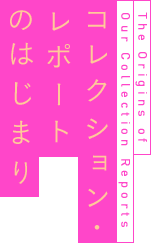
1927
少し時代をさかのぼって、
近代のファッションページは
どのようなものだったのでしょうか。
まず触れたいのは、『花椿』の前身である『資生堂月報』1927年2月号から始まった「巴里通信」というコラムについて。パリの最先端の美容・ファッション情報を挿絵とともに紹介するこの企画は、当時、資生堂の意匠部(現宣伝・デザイン部)所属でパリ特派員だった川島理一郎によるもので、この企画から、現在の『花椿』における海外のファッション情報発信が始まりました。
Let’s rewind the clock a bit and
look at how fashion pages
have evolved in the modern era.
First, let’s touch upon Hanatsubaki’s predecessor, the “Paris Tsushin” column, which first appeared in Shiseido Geppo in its February 1927 issue. This project to feature the latest beauty and fashion information out of Paris together with artwork was the brainchild of Riichiro Kawashima, the Paris correspondent who belonged to the then-Design Department (the present-day Advertisement & Design Department). It was from this project that the distribution of overseas fashion information now being carried on by the modern-day Hanatsubaki began.
1933
つづく『資生堂グラフ』には
銀座の街角スナップが
見受けられるようになります。
和装と洋装の「モダンガール」が銀座の街を行き交うようすに、日本のファッション情報ページの黎明をみることができます。
Next, snapshots of scenes
from the streets of Ginza began
being featured in SHISEIDO GRAPH.
Through the scenes of “Modern Girls” walking the streets of Ginza dressed in both traditional Japanese clothing and Western styles, one can see the dawn of Japan’s fashion information pages.
1937年に創刊した『花椿』の初期は、海外のトレンドを日本の服装に取り入れたスタイル提案や、パリ帰りの著名人や来日したフランス夫人にエスプリを聞く伝聞調のトレンド情報が主流でした。
Initially, when Hanatsubaki’s first issue was released in 1937, its primary role was to propose styles of Japanese traditional dress which incorporated overseas trends and to relay information on the latest vogues gathered from notable figures returning from Paris or French women visiting Japan.
1950
戦後、復刊した1950年からは
ビジュアル中心のページとなり、
主にニューヨークとパリからの
トレンド情報が紹介されました。
ハリウッドの情報も多くありましたが、こちらはビューティー情報に限られていたことから、「美容はハリウッド、ファッションはニューヨークまたはパリ」という意識が垣間見られます。
In 1950, when the magazine began publishing
again for the first time after WW2,
it focused more on the visual aspects fashion
providing information on trends prevalent
in New York and Paris.
There was also a great deal of information on Hollywood, but this was limited to beauty tips, so we are given a glimpse of the idea that “Beauty comes from Hollywood, Fashion comes from New York and Paris”.
1955
1953年、日本は現代のファッション元年ともいうべき節目を迎えます。
11月、パリのメゾン、クリスチャン ディオールが東京会館で日本初のファッションショーを開催したのです。この年はほかにも、7月にモデルの伊東絹子が世界ミスユニバースで第3位に入賞し、世間では「八頭身」ということばが流行したこともあり、日本で広くファッションへの関心が高まった年といえるでしょう。
1953 marked the first ever milestone
for the birth of Japan’s modern day
fashion industry.
In November of that year, top French designer Christian Dior held Japan’s first ever fashion show at Tokyo Kaikan. 1953 was also the year that Japanese model Kinuko Ito came third in the Miss Universe contest, with the word “hattoshin” (roughly translated as “beautiful, well-proportioned women with body length eight times that of her head”) being the latest fashion buzzword. As such, 1953 can be considered the year that Japanese people’s awareness of fashion really began to heighten.
1959
その影響を受けて、1954年からは
凝ったつくりのファッションページが
多く見られるようになりました。
モード発信の定番都市に限らず、スイスやオランダなどのモード、ウィンブルドン会場でのおしゃれ情報、クリスチャン ディオールのモスクワでのファッションショーのドキュメントなど、角度を変えたファッション企画も登場。そして、1959年9月号のジャン パトゥと連携したコレクション・レポート企画から『花椿』におけるコレクション・レポートが始まります。当時世界一のエレガンスといわれた同ブランドが紹介する最新モードは、いま見てもモダンそのものです。
As a result of this,
many exquisitely-presented fashion pages
began to emerge from 1954 onwards.
Fashion projects with different angles began appearing, showing the latest modes from not only the standard trend-setting cities but also Switzerland, Holland, and so forth, as well as fashion information from Wimbledon, documentaries on Christian Dior’s fashion shows in Moscow, and more. Then, the Collection Report produced in collaboration with Jean Patou featured in the September 1959 issue, marking the beginning of Hanatsubaki’s collection reports. The latest modes introduced by what was then known as the most elegant brand in the world still have a modern feel about them even today.







